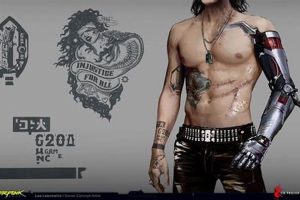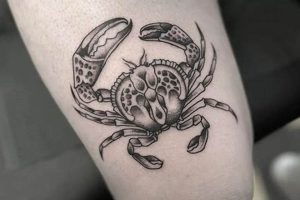Tattoos inspired by Japanese aesthetics encompass a rich visual tradition, often featuring bold colors, intricate details, and symbolic imagery drawn from nature, folklore, and mythology. Common motifs include dragons, koi fish, cherry blossoms, peonies, and samurai. These designs frequently incorporate flowing lines, dynamic compositions, and a sense of movement, creating visually striking and meaningful body art.
This distinctive style holds cultural significance, rooted in centuries-old artistic practices like ukiyo-e woodblock prints and traditional Japanese painting. The selection and placement of specific elements can convey personal narratives, embody virtues, or offer protection. The enduring appeal of this aesthetic lies in its powerful imagery, timeless elegance, and capacity for profound personal expression. Its influence continues to inspire contemporary tattoo artists and enthusiasts worldwide.
Further exploration will delve into specific design elements, their historical context, and the process of selecting and collaborating with a skilled artist specializing in this intricate art form.
1. Imagery (Dragons, Koi, Oni)
Dragons, koi fish, and oni (demons) constitute core iconic figures in Japanese tattooing, each imbued with rich symbolism and narrative potential. Dragons, representing strength, wisdom, and protection, often appear as dynamic, serpentine figures amidst clouds or waves. Koi, symbolizing perseverance, courage, and good fortune, are frequently depicted swimming upstream or adorned with flowing water motifs. Oni, while often perceived as malevolent figures, can also represent resilience and warding off evil spirits. These figures, drawn from Japanese folklore and mythology, provide a powerful visual language for expressing personal values and aspirations within the tattoo design.
The selection and depiction of these iconic figures significantly impact the overall meaning and aesthetic of a Japanese-style tattoo. A dragon ascending towards the heavens might represent ambition and overcoming adversity, while a descending dragon could symbolize achieving enlightenment or inner peace. Similarly, a brightly colored koi swimming upstream embodies resilience and the pursuit of goals, whereas a black koi can represent overcoming a significant challenge. The skillful integration of these figures with complementary elements like flowers, water, or wind further enriches the narrative complexity of the tattoo.
Understanding the symbolism associated with dragons, koi, and oni is crucial for creating a meaningful and culturally resonant Japanese-style tattoo. Collaborating with a knowledgeable artist allows for informed decisions regarding the specific depiction and placement of these elements, ensuring the final design aligns with the individual’s desired message and aesthetic preferences. This informed approach honors the rich cultural heritage of Japanese tattooing while facilitating powerful personal expression.
2. Color Palettes (Bold, Contrasting)
Color palettes play a crucial role in Japanese-style tattooing, contributing significantly to the overall aesthetic impact and symbolic meaning. Bold, contrasting colors are characteristic of this style, creating visually striking designs that capture attention and convey a sense of dynamism. Understanding the traditional use of color is essential for creating an authentic and impactful piece.
- Primary Colors:
Black, often utilizing varying shades for depth and shading (sumi), forms the foundation of many Japanese tattoos. Red, representing strength, passion, and protection, frequently features prominently alongside black. These colors are used as both outlines and dominant fills for key elements.
- Secondary Colors:
Gold, symbolizing prosperity and good fortune, frequently accents key features. Other secondary colors, such as greens, blues, and purples, add depth and complexity to the design, depicting natural elements like water, foliage, or sky, contributing to the overall narrative.
- Contrast and Harmony:
The interplay of bold colors creates a dynamic visual experience. The juxtaposition of black and red, for example, immediately draws the eye and emphasizes the central figures. Skillful color placement ensures harmony and balance, even with contrasting hues, preventing the design from becoming visually overwhelming.
- Color Symbolism:
Color choices can carry symbolic weight. For instance, pink cherry blossoms represent the fleeting nature of beauty and life, while deep blues evoke the power and mystery of the ocean. Careful consideration of color symbolism adds layers of meaning to the design, reflecting personal values and beliefs.
The strategic use of color in Japanese-style tattooing extends beyond mere aesthetics. It enhances the narrative, emphasizes symbolism, and creates a visually powerful and enduring work of art. Choosing an experienced artist well-versed in the nuances of traditional color palettes is crucial for achieving a cohesive and meaningful design.
3. Composition (Flowing, dynamic)
Composition is fundamental to Japanese-style tattooing, dictating the arrangement of elements to create a cohesive, visually appealing, and meaningful design. The style emphasizes dynamic, flowing compositions that follow the body’s natural contours, resulting in a harmonious integration of art and anatomy. Understanding compositional principles is crucial for creating a successful Japanese-style tattoo.
- Flow and Movement:
Japanese tattoo designs often evoke a sense of motion and fluidity. Elements like dragons, koi fish, and swirling water are arranged to create visual pathways that guide the eye across the body. This dynamic flow enhances the narrative and imbues the tattoo with a sense of life and energy.
- Balance and Harmony:
Despite the complexity and detail often present, Japanese-style tattoos strive for balance and harmony. Elements are strategically placed to create visual equilibrium, preventing any single area from dominating the composition. This balance ensures a cohesive and aesthetically pleasing design.
- Negative Space:
The use of negative space, the areas left un-tattooed, plays a vital role in Japanese tattoo composition. Negative space provides visual breathing room, preventing the design from appearing cluttered. It can also be used strategically to enhance the prominence of key elements and contribute to the overall flow.
- Body Suit Considerations:
In larger-scale projects, such as full body suits or sleeves, composition takes on added complexity. The design must flow seamlessly across multiple body parts, maintaining coherence and visual harmony. Skilled artists carefully plan these large-scale compositions to ensure a unified and impactful result.
Masterful composition elevates Japanese-style tattooing beyond mere decoration, transforming it into a dynamic and expressive art form. A well-composed design enhances the narrative, emphasizes symbolism, and creates a visually captivating piece that integrates seamlessly with the body’s form. The synergy between composition and subject matter is key to achieving a truly impactful and meaningful Japanese-style tattoo.
4. Placement (Body suit, individual pieces)
Placement is integral to Japanese-style tattooing, influencing the overall aesthetic and narrative flow. Traditional placement considers the body’s natural lines and musculature, maximizing visual impact and creating a harmonious relationship between the design and the wearer’s physique. Whether a single piece or a full body suit (Horimono), careful consideration of placement enhances the tattoo’s storytelling potential.
- Traditional Body Suits (Horimono):
Horimono, traditional Japanese body suits, often exclude the head, hands, and feet, allowing for social adaptability in various contexts. These large-scale compositions incorporate a complex interplay of imagery and symbolism, often narrating stories from folklore or mythology. The placement of individual elements within the Horimono follows established conventions, contributing to a cohesive and balanced overall design.
- Individual Pieces:
Smaller, individual tattoos offer flexibility in placement, allowing for focused expression of specific themes or symbols. Common locations include the back, chest, arms, and legs. Even with individual pieces, consideration of the body’s contours and the surrounding negative space remains crucial for achieving a visually balanced and impactful design.
- Placement and Flow:
Placement influences how the eye moves across the tattoo. Elements are often arranged to create a sense of flow and movement, guiding the viewer’s gaze through the narrative depicted. For example, a dragon might be positioned to wrap around the arm or torso, emphasizing its sinuous form and dynamic energy.
- Cultural Significance:
Historically, certain placements held specific cultural meanings. While these meanings may not always be strictly adhered to in contemporary tattooing, understanding their historical context can inform design choices and demonstrate respect for the tradition. For example, tattoos on the chest were traditionally associated with courage and protection.
The interplay between placement, imagery, and composition distinguishes Japanese-style tattooing. Strategic placement enhances the narrative power and visual impact of the design, creating a powerful and aesthetically compelling work of art that integrates seamlessly with the body. Choosing a knowledgeable artist experienced in traditional Japanese placement conventions is paramount for achieving a successful and meaningful tattoo.
5. Symbolism (Nature, mythology)
Symbolism is the cornerstone of Japanese-style tattooing, imbuing each design with layers of meaning drawn from nature, mythology, and folklore. Understanding this rich symbolic language is crucial for appreciating the depth and cultural significance of these tattoos. The choice of imagery, color palette, and composition contributes to a complex narrative that reflects personal values, beliefs, and aspirations.
- Nature’s Influence:
Natural elements hold profound meaning in Japanese culture and feature prominently in tattoo designs. Cherry blossoms symbolize the transient nature of life and beauty, while chrysanthemums represent longevity and joy. Animals like dragons, koi fish, and tigers embody strength, courage, and good fortune. Depictions of waves, wind, and clouds further enhance the dynamic and expressive quality of the tattoo.
- Mythological Creatures:
Japanese mythology provides a rich source of symbolic imagery. Dragons, representing wisdom, protection, and good fortune, often appear as powerful, serpentine figures amidst clouds or waves. Kirin, mythical hooved creatures associated with benevolence and prosperity, symbolize good omens and auspicious beginnings. These mythical beings add an element of fantasy and wonder to the tattoo, enriching its narrative potential.
- Folklore and Legends:
Stories from Japanese folklore inspire tattoo designs, imbuing them with historical and cultural context. Heroes, warriors, and legendary figures provide powerful visual metaphors for personal qualities like strength, resilience, and honor. These narratives connect the wearer to a rich cultural heritage, adding depth and meaning to the tattoo.
- Spiritual and Philosophical Concepts:
Japanese-style tattoos can also express spiritual or philosophical concepts. The lotus flower, emerging from murky water to bloom in pristine beauty, symbolizes enlightenment and spiritual awakening. The interplay of yin and yang represents the balance of opposing forces in the universe. These symbolic representations add a layer of intellectual and spiritual depth to the tattoo.
The intricate interplay of nature, mythology, and folklore in Japanese-style tattooing creates a powerful visual language that transcends mere decoration. Each element contributes to a complex narrative that reflects the wearer’s personal journey, values, and aspirations. This deep symbolism elevates the tattoo to a powerful form of personal expression, connecting the individual to a rich cultural heritage and imbuing the design with profound meaning.
6. Artist Selection (Expertise Crucial)
Selecting a skilled artist specializing in Japanese-style tattoos is paramount. This intricate art form demands technical expertise and a deep understanding of its cultural and historical context. A skilled artist possesses mastery of linework, shading, color theory, and composition specific to the style. They understand the symbolism associated with various motifs and can guide clients toward culturally appropriate and personally meaningful designs. Choosing an inexperienced or unqualified artist can result in a poorly executed tattoo that lacks authenticity and may even misrepresent or disrespect the cultural heritage it draws upon. For example, a dragon depicted with incorrect features or placed inappropriately on the body could alter its symbolic meaning, potentially conveying an unintended or even offensive message.
The collaborative process between artist and client is essential. A skilled artist takes the time to understand the client’s vision, offering guidance and expertise to refine the design and ensure its suitability for the chosen placement. They consider the client’s body type, skin tone, and personal preferences, creating a custom design that integrates seamlessly with the individual’s physique. This collaborative approach ensures that the final tattoo is not only aesthetically pleasing but also deeply personal and meaningful. Researching artists’ portfolios, seeking recommendations, and consulting with potential artists are crucial steps in finding the right match for a Japanese-style tattoo. Evaluating an artist’s experience, attention to detail, and understanding of traditional techniques helps ensure a successful and satisfying outcome.
Ultimately, the quality and authenticity of a Japanese-style tattoo depend significantly on the artist’s skill and understanding. Investing time and effort in selecting a qualified artist is an investment in the tattoo itself, ensuring a piece of art that holds both aesthetic and cultural value. A well-executed Japanese-style tattoo becomes a powerful expression of personal identity, reflecting the wearer’s appreciation for this rich artistic tradition and their commitment to honoring its cultural heritage.
Tips for Choosing Japanese Style Tattoo Designs
Careful consideration of several factors ensures a meaningful and aesthetically pleasing tattoo that honors the rich traditions of Japanese art.
Tip 1: Research Thoroughly: Deepen understanding of Japanese art, mythology, and symbolism. Explore various motifs and their cultural significance to select elements resonant with personal values and aesthetics.
Tip 2: Prioritize Artist Selection: Seek a skilled artist specializing in Japanese-style tattoos. Examine portfolios for technical expertise, attention to detail, and understanding of traditional techniques. A knowledgeable artist provides invaluable guidance throughout the design process.
Tip 3: Collaborative Design Process: Engage actively with the chosen artist. Open communication ensures the final design reflects personal preferences while adhering to traditional artistic conventions. Discuss placement, color palettes, and symbolism to create a cohesive and meaningful piece.
Tip 4: Placement Considerations: Consider the body’s natural contours and how the tattoo will flow across them. Traditional placements often hold symbolic meaning. Discuss placement options with the artist to ensure the design complements the body’s form and enhances the narrative.
Tip 5: Color Palette Significance: Understand the traditional color palettes used in Japanese tattooing. Bold, contrasting colors often hold symbolic weight. Discuss color choices with the artist to create a visually striking and meaningful design.
Tip 6: Size and Scale: Consider the desired size and scale of the tattoo. Larger pieces allow for greater detail and complexity, while smaller tattoos offer focused expression. Balance desired imagery with available space and body placement.
Tip 7: Long-Term Commitment: Recognize the permanence of tattoos. Japanese-style tattoos, often large and intricate, require significant time, financial investment, and aftercare. Ensure a lifelong commitment to the chosen design and the ongoing maintenance it requires.
These considerations empower informed decisions, resulting in a tattoo that embodies personal expression while respecting the cultural heritage of Japanese art. A well-chosen design becomes a powerful and enduring work of art, reflecting a deep appreciation for this rich tradition.
By following these guidelines, individuals can embark on the journey of acquiring a Japanese-style tattoo with confidence and clarity, ensuring a result that is both aesthetically striking and deeply meaningful.
Frequently Asked Questions about Japanese Style Tattoos
Addressing common queries regarding design, symbolism, artist selection, and the cultural significance of Japanese-style tattoos provides clarity for those considering this art form.
Question 1: How does one choose appropriate imagery for a Japanese-style tattoo?
Imagery selection should reflect personal values and resonate with the rich symbolism inherent in Japanese art and mythology. Researching various motifs (dragons, koi fish, flowers) and their cultural significance aids informed decision-making. Consulting with a knowledgeable artist further clarifies symbolic meanings and ensures appropriate representation.
Question 2: What factors contribute to finding a reputable and skilled artist specializing in this style?
Expertise in Japanese tattooing requires technical mastery and cultural understanding. Thorough portfolio reviews showcasing linework, color application, and composition are crucial. Seeking recommendations, verifying artist experience, and discussing their knowledge of traditional techniques and symbolism ensure informed selection.
Question 3: How does the placement of a Japanese-style tattoo impact its overall aesthetic and meaning?
Traditional placement often follows the body’s natural contours and can hold symbolic meaning. Placement considerations, whether for a single piece or a full body suit (Horimono), should enhance the narrative flow and visual impact. Consulting with a skilled artist ensures appropriate and aesthetically pleasing placement.
Question 4: What is the significance of color in Japanese-style tattoos?
Color palettes contribute significantly to aesthetics and symbolism. Bold, contrasting colors are characteristic, often holding specific cultural meanings. Understanding traditional color associations and discussing preferences with the artist ensures a visually impactful and symbolically resonant design.
Question 5: How does one ensure a Japanese-style tattoo respects cultural traditions?
Respect for cultural heritage is paramount. Thorough research, artist selection, and collaborative design discussions ensure authentic representation. Choosing a knowledgeable artist who understands and respects traditional techniques, symbolism, and placement conventions avoids misrepresentation or cultural appropriation.
Question 6: What long-term care and maintenance are required for these tattoos?
Japanese-style tattoos, especially large-scale pieces, require ongoing care and maintenance. Following aftercare instructions diligently, protecting the tattoo from sun exposure, and using appropriate moisturizing products preserves vibrancy and longevity. Consulting with the artist about long-term care ensures the tattoo remains a vibrant piece of art.
Careful consideration of these aspects ensures a fulfilling experience, resulting in a tattoo that honors both personal expression and the rich cultural legacy of Japanese art.
Further exploration can delve into specific design elements, artist portfolios, and the historical evolution of Japanese tattooing.
Japanese Style Tattoo Ideas
Exploration of this rich art form reveals its profound connection to Japanese history, mythology, and artistic traditions. Key elements, including impactful imagery, vibrant color palettes, dynamic compositions, and strategic placement, contribute to the creation of deeply meaningful and visually striking tattoos. The significance of selecting a skilled artist knowledgeable in traditional techniques and symbolism cannot be overstated. Understanding the cultural context and symbolic depth inherent in these designs ensures respectful and authentic representation.
Japanese-style tattoos offer a powerful medium for personal expression, intertwining individual narratives with a centuries-old artistic legacy. Careful consideration of design choices, coupled with collaboration with a skilled artist, results in a timeless piece of art that embodies both personal and cultural significance. This enduring art form continues to evolve while honoring its rich heritage, offering a captivating blend of tradition and contemporary expression.







